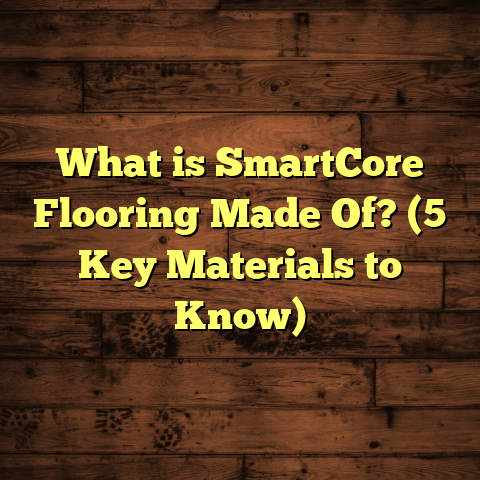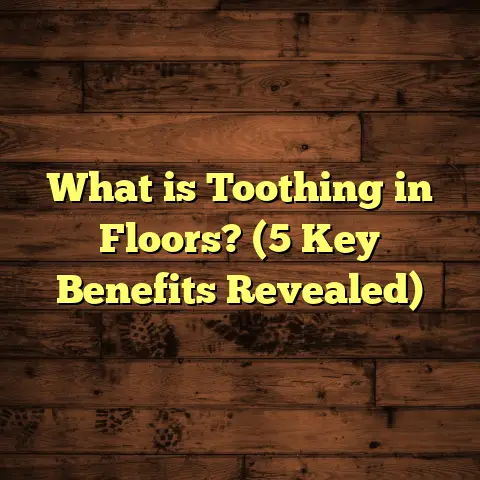What is Non-Porous Flooring? (5 Key Benefits for Homeowners)
What if you spilled a glass of red wine on your floor and it just sat there, untouched by the stain or any damage? Imagine not having to panic over little accidents that seem to ruin your home’s flooring. Sounds like magic, right? Well, that’s exactly one of the perks of non-porous flooring.
What is Non-Porous Flooring?
Let me break it down for you. Non-porous flooring refers to floor materials that do not have pores or tiny openings on their surface. These floors don’t absorb liquids, dirt, or bacteria because their surface is sealed tight. Think of them as the impervious barrier between your floor and whatever spills or messes life throws at it.
Unlike porous materials like natural wood or stone that soak up moisture and stains, non-porous floors repel these substances. This is a game-changer for anyone who wants easy cleaning and durability.
Non-porous floors can be made from various materials such as vinyl, ceramic tile, certain types of laminate, polished concrete, and some engineered stones. The key is that the surface acts like a shield—nothing penetrates it.
When I first started working with clients, many were surprised by how different non-porous flooring performs compared to traditional options. I’ve seen kitchens with tile floors survive years of spills without a single stain, and basements with polished concrete remain mold-free despite occasional water exposure. This firsthand experience shaped my strong recommendation for non-porous options in high-traffic or moisture-prone areas.
Why Should You Care About Non-Porous Floors?
Here’s something I always ask homeowners: How often do you worry about accidental spills or pet messes ruining your floors? If you’re anything like most people, that worry is real and constant.
Non-porous floors take away a lot of that stress. They provide peace of mind and save time on cleaning. You can literally wipe up spills without scrubbing or worrying about long-term damage.
Let me share a quick example from a recent project. A family with two young kids and a dog chose vinyl non-porous flooring for their living room and kitchen. After six months, they reported zero stains and minimal cleaning effort—even after juice spills, muddy paws, and dropped snacks. That’s a big win in my book.
5 Key Benefits of Non-Porous Flooring for Homeowners
1. Superior Resistance to Stains and Moisture
One of the biggest headaches with traditional flooring is staining. Spills seep into porous surfaces like wood or natural stone, leaving marks that can be tough to remove.
With non-porous flooring, liquids simply sit on top until you wipe them away. This means no absorption, no discoloration, and no lingering smells. For households with kids, pets, or frequent cooks, this benefit alone can save hundreds in maintenance costs.
To put numbers behind this, studies show that vinyl flooring (a common non-porous material) resists moisture absorption at less than 0.01%, compared to hardwood’s 6-8%. This drastically reduces chances of swelling, warping, or mold growth.
I remember working on a home renovation where the client had previously installed porous stone tiles in their kitchen. Over time, they complained about stubborn stains from oil and wine that no cleaner could touch. When we switched them to porcelain tiles with a glazed finish—100% non-porous—their cleaning routine became effortless. No more scrubbing or specialized products needed.
2. Easier Cleaning and Maintenance
If you hate scrubbing grout lines or sanding hardwood floors every year, you’re going to love how simple non-porous floors are to maintain.
Because dirt and grime don’t sink into the material, a quick mop or wipe with mild cleaner usually does the trick. No need for harsh chemicals or specialized treatments.
In my experience working with older homeowners, this ease of upkeep often makes non-porous floors their preferred choice. It reduces physical effort and keeps their homes looking fresh with minimal fuss.
I once installed non-porous tile in a kitchen for a client who used to spend hours cleaning her old wood floor. She told me afterward she had more free time now and didn’t dread cleaning anymore.
Beyond ease of cleaning, non-porous floors typically do not require sealing or refinishing annually like some hardwood or stone surfaces do. This cuts down on maintenance expenses significantly.
3. Enhanced Hygiene and Allergy Control
Here’s a point many people overlook: porous flooring can harbor dust mites, allergens, and bacteria deep within its surface. This is especially true for carpets or untreated wood.
Non-porous floors don’t offer hiding spots for these irritants since nothing penetrates the surface. Wiping with disinfectants is far more effective on these floors.
For families with allergy sufferers or asthma patients, this can mean better indoor air quality and fewer symptoms triggered by dust or mold spores trapped in flooring.
A case study I reviewed recently revealed homes with non-porous floors had 30% fewer reported allergy issues compared to those with carpeted or porous wood floors. That’s a noticeable health benefit worth considering.
From personal experience, clients with young children—who are more vulnerable to allergens—often choose non-porous options to reduce exposure risks. One mother told me her son’s eczema improved after they replaced carpeted bedrooms with vinyl planks that are easy to clean and don’t trap dust.
4. Durability and Longevity
When I assess floors for clients, durability is always top of mind. Non-porous materials generally withstand wear and tear better because they don’t absorb moisture or stains that weaken structure over time.
Materials like polished concrete or ceramic tile can last decades with proper care—much longer than untreated hardwood which often needs sanding and refinishing every few years.
In one project I managed for a commercial kitchen renovation, the owner chose non-porous epoxy flooring. After five years of heavy daily use, the floor looked almost brand new—no cracks or stains in sight.
Another example is vinyl plank flooring—which has surged in popularity due to its toughness combined with realistic wood-look finishes. Many manufacturers now offer warranties up to 25 years on wear resistance because these floors handle scratches and dents well.
5. Better Value Over Time
You might think non-porous floors cost more upfront but hear me out on this one. While initial installation might be comparable or slightly higher than traditional options, the savings on maintenance and repairs add up quickly.
Fewer replacements, less cleaning effort, and lower risk of mold damage contribute to long-term value. Plus, many non-porous materials are available in styles that mimic expensive hardwood or stone without the price tag.
I often encourage homeowners to think about flooring as an investment. A quality non-porous floor can pay for itself within five to ten years through reduced upkeep costs.
For example:
- Hardwood floors may require refinishing every 7–10 years costing $2–4 per square foot.
- Non-porous vinyl planks typically only need occasional cleaning costing cents per square foot.
- Replacing water-damaged wood can cost thousands; non-porous floors avoid this risk entirely.
The Science Behind Non-Porous Surfaces
You might wonder what makes a floor truly non-porous on a microscopic level? It all comes down to material composition and manufacturing processes.
Porosity measures how much void space exists in a material where liquids or gases can enter. Materials like wood have open cellular structures that absorb moisture easily. Stone varies—marble is porous; granite less so; porcelain tile is nearly impermeable due to dense clay fired at high temperatures.
Many non-porous floors have additional coatings or sealants applied:
- Vinyl planks have multiple layers including a waterproof core.
- Ceramic tiles are glazed with glass-like coatings.
- Engineered stones use resins to fill pores completely.
- Polished concrete is densified using chemical hardeners that close surface pores.
These methods reduce absorption rates dramatically—some down to nearly zero—which prevents stains, mold growth, and structural damage caused by moisture infiltration.
Personal Stories: How Non-Porous Flooring Changed My Clients’ Lives
I want to share two stories illustrating how choosing non-porous flooring transformed day-to-day life for homeowners I worked with:
Story 1: The Busy Family Kitchen
Jessica and Mark had two toddlers and a golden retriever—chaos was part of their daily routine! They constantly worried about juice spills staining their oak hardwood kitchen floor and muddy paw prints ruining the finish.
When they renovated their home last year, we recommended luxury vinyl plank (LVP), known for being completely waterproof and scratch-resistant while mimicking real wood texture beautifully.
Six months later Jessica called me excited: “No stains at all! And cleaning is so simple—I just mop up messes right away without worrying about damage.”
For them, the switch meant less stress and more time playing with their kids instead of fixing floors.
Story 2: The Allergy-Sensitive Household
Linda’s family struggled with severe allergies triggered by dust mites in their carpeted bedrooms. After consulting me about alternatives, they installed porcelain tile throughout the house with area rugs that were easy to wash.
The results surprised them: “Our sneezing fits have reduced significantly,” Linda said. “I never thought changing flooring could impact our health so much.”
This case shows how non-porous flooring can improve quality of life beyond aesthetics.
Types of Non-Porous Flooring: Pros and Cons
If you’re thinking about switching to non-porous flooring, here’s an overview of popular options I recommend often:
Vinyl Flooring
Pros:
- Waterproof
- Affordable
- Easy installation (DIY-friendly)
- Wide range of styles including wood-look planks
- Soft underfoot compared to tile or concrete
Cons:
- Can dent under heavy furniture
- Not biodegradable (environmental concern)
Vinyl’s popularity has exploded due to technology improving durability while keeping costs low.
Ceramic & Porcelain Tile
Pros:
- Extremely durable
- Heat resistant
- Variety of colors and patterns
- Great for high-moisture areas like bathrooms/kitchens
Cons:
- Can be cold/hard underfoot
- Installation requires skill (grout lines need sealing)
- Tiles may chip if heavy objects drop
Polished Concrete
Pros:
- Industrial look trend
- Very durable
- Waterproof when sealed properly
- Low maintenance
Cons:
- Hard and cold surface
- Professional installation required
- Limited color options unless stained
Engineered Stone & Quartz Composite
Pros:
- Natural stone appearance without porosity
- Scratch-resistant
- Low maintenance
Cons:
- Can be expensive
- Heavy material needing professional installation
Installation Tips for Non-Porous Flooring
Based on my experience installing these floors extensively:
- Prepare Subfloor Properly
A flat, clean subfloor ensures better adhesion and prevents cracking in tile or vinyl. - Allow Acclimation Time
Some materials like vinyl may need 48 hours in your home environment before installation to adjust temperature/humidity changes. - Seal Grout Lines
With tile floors, sealing grout regularly prevents staining despite tile being non-porous itself. - Use Appropriate Underlayment
For vinyl or engineered stone tiles over concrete slabs, underlayment helps with moisture barriers and soundproofing. - Hire Professionals When Needed
Complex jobs like polished concrete grinding or tile layout often require skilled installers for best results.
Caring for Your Non-Porous Floors: Maintenance Tips
Keeping your floor looking great doesn’t have to be hard:
- Sweep or vacuum regularly to remove dirt that could scratch surfaces.
- Mop with pH-neutral cleaners designed for your floor type.
- Avoid abrasive scrubbers which can damage finishes.
- Wipe spills immediately but remember these floors won’t absorb liquids anyway.
- Periodically reseal grout lines if applicable.
Following these simple practices extends your floor’s life significantly while preserving appearance.
How Non-Porous Flooring Fits Different Lifestyles
Whether you live alone in a downtown apartment or have a busy household with pets and kids, non-porous flooring adapts well:
For Pet Owners
Non-porous floors resist urine stains and odors better than carpet or wood which soak in smells deeply requiring expensive treatments later.
A client once told me their dog had an accident on vinyl plank flooring—just wiped it up with no lasting smell or damage after years living there!
For Allergy Sufferers
Easy-to-clean surfaces reduce dust accumulation—a huge benefit if you suffer from asthma or allergies.
For Families With Kids
Kids spill drinks all the time! Floors that don’t stain make parenting less stressful when your toddler drops juice or snacks on the floor daily.
For Entertainers & Hosts
If you host parties frequently where spills are inevitable, having a floor that handles messes gracefully lets you relax instead of stressing over damage afterward.
Environmental Impact of Non-Porous Flooring
Some people worry about environmental effects when choosing flooring materials:
Vinyl production involves plastics which aren’t biodegradable but many manufacturers now offer recycling programs reducing landfill waste significantly.
Ceramic tiles have long lifespans reducing need for replacements—one tile can last decades if cared for properly which minimizes resource use over time.
Polished concrete uses existing slabs reducing raw material extraction compared to new flooring installations overall lowering carbon footprint.
Engineered stones often utilize recycled materials making them relatively eco-friendly compared to quarried natural stone alternatives.
If sustainability matters deeply to you, ask your supplier about certifications like FloorScore (indoor air quality), GreenGuard (low chemical emissions), or FSC-certified underlayments where applicable.
Cost Breakdown & Budgeting Advice
I get asked all the time: “How much does non-porous flooring cost?” Here’s an overview based on recent projects:
| Flooring Type | Material Cost per sq.ft | Installation Cost per sq.ft | Total Avg Cost per sq.ft |
|---|---|---|---|
| Vinyl Plank | $2 – $5 | $1 – $3 | $3 – $8 |
| Ceramic / Porcelain | $3 – $10 | $4 – $10 | $7 – $20 |
| Polished Concrete | $2 – $6 | $3 – $8 | $5 – $14 |
| Engineered Stone | $7 – $15 | $5 – $10 | $12 – $25 |
Prices vary by region, complexity of installation (e.g., patterns), and material quality but this gives you ballpark figures for budgeting purposes.
Using tools like FloorTally can help customize estimates based on local labor costs plus waste factors so you’re not caught off guard by surprises later on.
How To Choose the Right Non-Porous Floor for Your Home
Choosing depends on several factors:
- Location — Wet areas benefit from waterproof tiles or vinyl; living rooms might favor warmer vinyl planks.
- Budget — Vinyl offers affordability; engineered stone delivers upscale looks but at higher prices.
- Lifestyle — Pets? Kids? Allergies? Pick durability and hygiene features accordingly.
- Aesthetic — Some prefer sleek concrete; others want realistic wood grain vinyl.
- Installation — DIY-friendly options vs professional requirements differ widely.
- Longevity Goals — How long do you plan to keep this floor? Long-term durability might justify higher upfront costs.
I always recommend ordering samples first — walk barefoot on them at different times of day under natural light — get a real feel before committing financially.
Frequently Asked Questions About Non-Porous Flooring
Can Non-Porous Floors Be Used Outdoors?
Some types like porcelain tiles are suitable for outdoor patios as they resist frost and moisture well; however polished concrete outdoors requires special sealers against weathering.
Vinyl generally isn’t recommended outside due to sun damage potential unless specifically rated for exterior use.
Are Non-Porous Floors Slippery?
It depends on finish—glazed tiles can be slick when wet whereas textured vinyl planks offer better traction reducing slip risks especially important in homes with elderly residents or kids learning to walk.
Will Non-Porous Floors Feel Cold?
Materials like tile and concrete tend to feel cooler than carpet or wood but adding rugs helps warm up spaces easily if needed without sacrificing benefits of low maintenance floors.
How Long Do They Last?
Many non-porous floors last 20 years plus if maintained properly; some types like polished concrete can go beyond 50 years making them very cost-effective choices long-term compared to traditional hardwood which might need replacement sooner due to moisture damage risks.
Wrapping Up My Thoughts on Non-Porous Flooring
Choosing your home’s flooring is more than just picking something pretty—it’s about finding something practical that fits your lifestyle while looking good for years ahead.
Non-porous flooring offers clear advantages: stain resistance, easier cleaning, better hygiene, durability, and long-term savings—all backed by solid science and real homeowner stories I’ve witnessed firsthand.
If you want floors that are easier to care for without sacrificing style or comfort, exploring non-porous materials should be high on your list.
Have you thought about trying any of these options? What concerns do you have around flooring choices? Feel free to ask—I’m happy to share what I’ve learned helping hundreds of homeowners find just the right fit!





